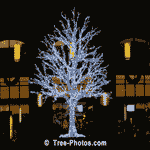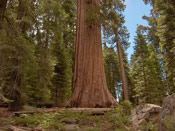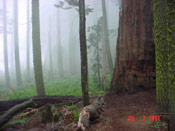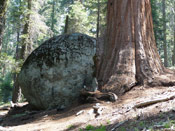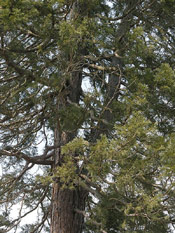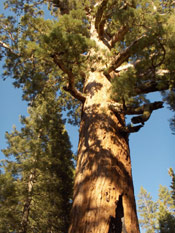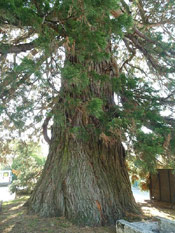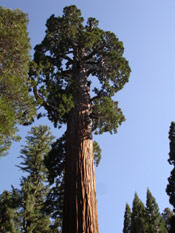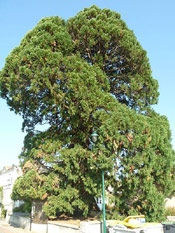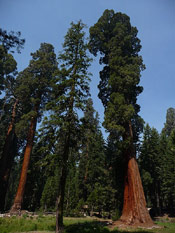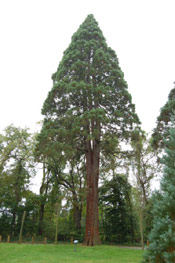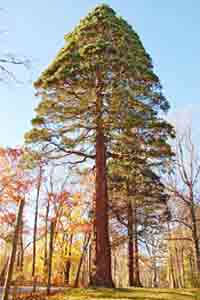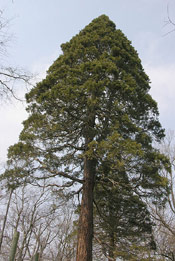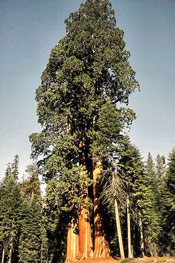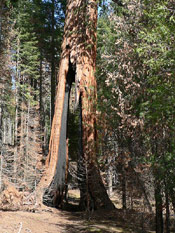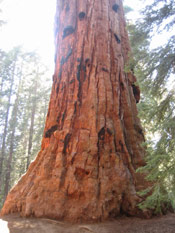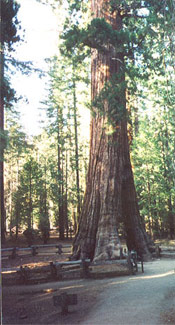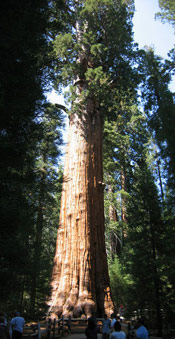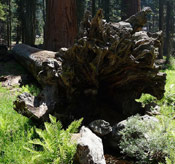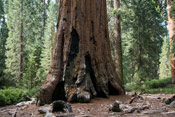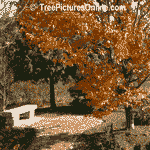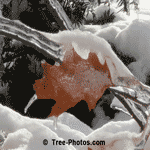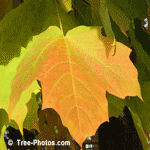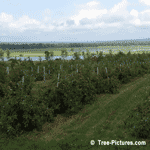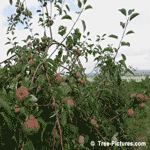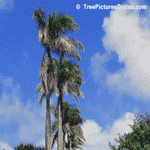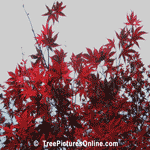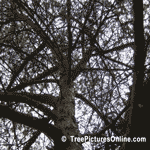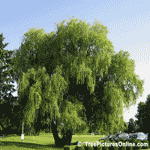Giant Sequoia Tree
Welcome to our giant sequoia tree pictures page.
On this page you will find lots of nice pictures of giant sequoia trees.
You will also find a lot of wonderful information on giant sequoia trees, including information about the giant sequoia tree species, planting information, and much more.
This is valuable and useful information that can help you to learn more about the giant sequoia tree.
Giant Sequoia Images
Full size each giant sequoia tree picture, just click on the giant sequoia tree image you like.
Enjoy these pictures of the Giant Sequoia
Sequoia: Giant Sequoia Pictures
Here is some general information on the sequoia tree.
Scientific name: Sequoiadendron giganteum
Sequoiadendron giganteum (giant sequoia, Sierra redwood, Sierran redwood, or Wellingtonia) is the sole living species in the genus Sequoiadendron, and one of three species of coniferous trees known as redwoods, classified in the family Cupressaceae in the subfamily Sequoioideae, together with Sequoia sempervirens (Coast Redwood) and Metasequoia glyptostroboides (Dawn Redwood). The common use of the name "sequoia" generally refers to Sequoiadendron, which occurs naturally only in groves on the western slopes of the Sierra Nevada Mountains of California.
Giant Sequoias are the world's largest trees in terms of total volume (technically, only 7 living Giant Sequoia exceed the 42,500 cubic feet (1,200 m3) of the Lost Monarch Coast Redwood tree; see Largest trees). They grow to an average height of 50 to 85 metres (160 to 279 ft) and 6 to 8 metres (20 to 26 ft) in diameter. Record trees have been measured to be 94.8 metres (311 ft) in height and 17 metres (56 ft) in diameter. The oldest known Giant Sequoia based on ring count is 3,500 years old. Sequoia bark is fibrous, furrowed, and may be 90 centimetres (3.0 ft) thick at the base of the columnar trunk. It provides significant fire protection for the trees. The leaves are evergreen, awl-shaped, 3 to 6 mm long, and arranged spirally on the shoots. The seed cones are 4 to 7 cm long and mature in 18 to 20 months, though they typically remain green and closed for up to 20 years; each cone has 30 to 50 spirally arranged scales, with several seeds on each scale giving an average of 230 seeds per cone. The seed is dark brown, 4 to 5 mm long and 1 mm broad, with a 1 mm wide yellow-brown wing along each side. Some seed is shed when the cone scales shrink during hot weather in late summer, but most seeds are liberated when the cone dries from fire heat or is damaged by insects.
Giant sequoia cones.Giant sequoia regenerates by seed. Trees up to about 20 years old may produce stump sprouts subsequent to injury. Giant sequoia of all ages may sprout from the bole when old branches are lost to fire or breakage, but (unlike coast redwood) mature trees do not sprout from cut stumps. Young trees start to bear cones at the age of 12 years.
At any given time, a large tree may be expected to have approximately 11,000 cones. The upper part of the crown of any mature Giant Sequoia invariably produces a greater abundance of cones than its lower portions. A mature giant sequoia has been estimated to disperse from 300,000-400,000 seeds per year. The winged seeds may be carried up to 180 m (600 ft) from the parent tree.
Lower branches die fairly readily from shading, but trees less than 100 years old retain most of their dead branches. Trunks of mature trees in groves are generally free of branches to a height of 20 to 50 m, but solitary trees will retain low branches.
The natural distribution of giant sequoia is restricted to a limited area of the western Sierra Nevada, California.
The giant sequoias are having difficulty reproducing in their original habitat (and very rarely reproduce in cultivation) due to the seeds only being able to grow successfully in mineral soils in full sunlight, free from competing vegetation. Although the seeds can germinate in moist needle humus in the spring, these seedlings will die as the duff dries in the summer. They therefore require periodic wildfire to clear competing vegetation and soil humus before successful regeneration can occur. Without fire, shade-loving species will crowd out young sequoia seedlings, and sequoia seeds will not germinate. When fully grown, these trees typically require large amounts of water and are therefore often concentrated near streams.
Fires also bring hot air high into the canopy via convection, which in turn dries and opens the cones. The subsequent release of large quantities of seeds coincides with the optimal post-fire seedbed conditions. Loose ground ash may also act as a cover to protect the fallen seeds from ultraviolet radiation damage.
Due to fire suppression efforts and livestock grazing during the early and mid 20th century, low-intensity fires no longer occurred naturally in many groves, and still do not occur in some groves today. The suppression of fires also led to ground fuel build-up and the dense growth of fire-sensitive White Fir. This increased the risk of more intense fires that can use the firs as ladders to threaten mature Giant Sequoia crowns. Natural fires may also be important in keeping carpenter ants in check.
The giant sequoia was well known to Native American tribes living in its area. Native American names for the species include Wawona, Toos-pung-ish and Hea-mi-withic, the latter two in the language of the Tule River Tribe.
Wood from mature giant sequoias is highly resistant to decay, but due to being fibrous and brittle, it is generally unsuitable for construction. From the 1880s through the 1920s logging took place in many groves in spite of marginal commercial returns. Due to their weight and brittleness trees would often shatter when they hit the ground, wasting much of the wood. Loggers attempted to cushion the impact by digging trenches and filling them with branches. Still, it is estimated that as little as 50 percent of the timber made it from groves to the mill. The wood was used mainly for shingles and fence posts, or even for matchsticks.
Giant Sequoia is a very popular ornamental tree in many areas. Areas where it is successfully grown include most of western and southern Europe, the Pacific Northwest of North America north to southwest British Columbia, the southern United States, southeast Australia, New Zealand and central-southern Chile. It is also grown, though less successfully, in parts of eastern North America.
Giant sequoias are grown successfully in the Pacific Northwest and southern US, and less successfully in eastern North America.
Immature seed (female) cones of cultivated tree in Portland, Oregon, USA (fall)Giant Sequoia cultivation is very successful in the Pacific Northwest from western Oregon north to southwest British Columbia, with fast growth rates. In Washington and Oregon, it is common to find giant sequoias that have been successfully planted in both urban and rural areas.
Collection of Impressive Tree Images
Trees: Recent Tree Photos, Pics & Images
|
|
|
|
|
|
|
|
|
|
|
|
|
|
|
Tree Facts, Trivia
United States land is covered by over 30 per cent with trees and forests
There are more than 20,000 different types of trees in the world.
Tree wallpaper images can make beautiful backgrounds on your computer`s desktop. See our tree wallpaper photographs link in the left tree categories.
Thank you for visiting our Tree Pictures at TreePicture Online.com, please come back soon for more great tree photos!
BookMark This Page

Pictures Sites
Fireplace Pictures -
Tree Pictures -
Gazebo Pictures -
Symbols & Their Meanings
Resume Samples -
Church Pictures -
Manufactured Home Pictures
Natural Log Siding -
Shadow Puppets -
Caribbean Islands
Play Touch Games -
Waterfall Pictures
Make Hot Pictures - Job Application Forms



